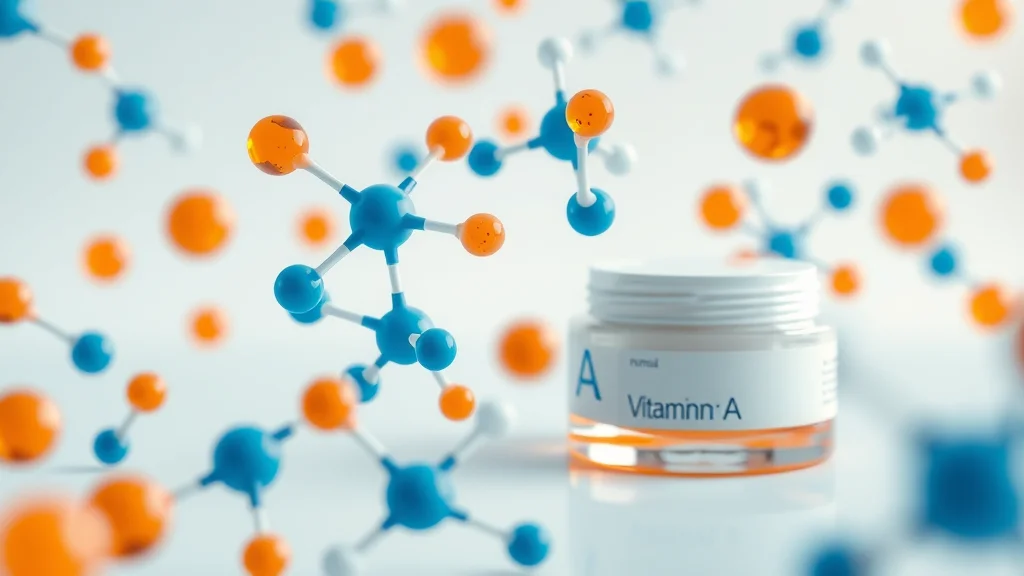Startling Fact: Did you know that “Over 70% of dermatologists recommend retinol as the gold standard for anti-aging treatments”? Once reserved for prescription use, retinol now headlines skin care routines worldwide for its powerful, research-backed impact on skin aging and complexion health. But how does this miracle ingredient actually work, and what should you know to safely incorporate it into your daily routine? In this comprehensive guide, we’ll break down the science, explore different forms of vitamin A, reveal common mistakes, and share proven application methods for optimal results. Your journey to more radiant, resilient skin starts here.
Retinol: The Groundbreaking Ingredient Transforming Skin Care
There’s a reason retionol (retinol) has sparked a revolution in the world of skin care. As a derivative of vitamin A, retinol has become a hero ingredient in everything from over-the-counter serums to dermatology-grade prescriptions. Its science-backed ability to reduce the appearance of fine lines and wrinkles, fade age spots, and boost skin cell renewal sets it apart from most active ingredients found in shelves of modern care products.
Unlike quick-fix fads, retinol’s efficacy is confirmed by a multitude of clinical studies. It works deep within the skin to accelerate turnover of dead skin cells, stimulate collagen, and counteract damage caused by sun exposure—all essential in slowing the march of skin aging. Retinol’s popularity also stems from its versatility; whether tackling acne in young adults or diminishing the visible signs of aging in mature skin, this ingredient offers results for nearly every age group and skin type. Read on for an in-depth look at why retionol is transforming the future of skin care.

"Over 70% of dermatologists recommend retinol as the gold standard for anti-aging treatments."
Understanding Retinol: What Is Retinol and How Does It Work?
Retinol is a form of vitamin A that’s structurally adapted to be easily absorbed and utilized by the skin. Once applied, it penetrates the upper layers and is enzymatically converted into retinoic acid, the bioactive form that binds to genetic regulators in skin cells. These receptors stimulate the production of new, healthy skin cells while paving the way for the exfoliation of dead skin. The result? Fewer clogged pores, improved tone and elasticity, and a dramatic reduction in fine lines and age spots.
As a keystone of modern skin care, retinol doesn’t just fight skin aging. By promoting faster turnover of dead skin cells and keeping pores clear, retinol products also significantly reduce acne and improve uneven pigmentation. More importantly, its effect on structural proteins like collagen and elastin helps maintain youthful bounce and firmness, making it an essential staple in any forward-thinking care routine.
Retinol Versus Retinoic Acid: Delving into the Science
Although often used interchangeably, retinol and retinoic acid are not the same when it comes to potency, accessibility, or side effects. Retinoic acid—commonly available as Retin-A—is the purest, most powerful active form and is typically only prescribed for stubborn skin conditions like acne or severe signs of skin aging. Retinol, available in numerous retinol products, is milder, requiring a metabolic conversion in the skin to become active but delivering substantial results over time with far less initial irritation.
This distinction is vital for users: while prescription retinoic acid can produce quicker outcomes, it often brings about increased skin irritation, peeling, and redness, especially in the initial weeks. Retinol offers a gentler, more gradual approach, making it a popular entry point for those looking to update their skin care arsenal without the stress of major side effects. The balance between efficacy and skin tolerance is why retinol remains a mainstay in both over-the-counter and professional skin care products.
What You'll Learn About Retinol
The science behind retinol’s efficacy
Differences between retinol, retinoic acid, and other forms of vitamin A
How to choose effective retinol products
Key side effects of retinol and strategies to minimize them
Evidence-based application tips for optimal results

Retinol, Retinoic Acid, and the Forms of Vitamin A: An In-Depth Comparison
Comparison of Retinol, Retinoic Acid, and Vitamin A Derivatives | ||||
Compound |
Potency |
Skin Tolerance |
OTC or Prescription |
Usage |
|---|---|---|---|---|
Retinol |
Moderate |
Generally Good |
OTC |
Anti-aging |
Retinoic Acid |
High |
Lower |
Prescription |
Acne, aging |
Retinyl Esters |
Low |
High |
OTC |
Preventive |
How Different Forms of Vitamin Benefit Skin Care
The forms of vitamin A used in skin care—retinol, retinoic acid, and retinyl esters—each provide unique benefits. Retinol is one of the most popular derivatives, striking a balance between effectiveness and skin tolerance. Retinoic acid binds directly to acid receptors in the skin, delivering potent results but with a higher likelihood of side effects like irritation or redness. Retinyl esters, such as retinyl palmitate, are even milder and often included in preventive skin care for first-time users or those with extremely sensitive skin.
Over time, the body must convert retinyl esters into retinol and then into retinoic acid, which accounts for their gentler action but slower results. These differences in biological activity and skin cell turnover help consumers match their skin condition and goals to the right retinol products. For example, those targeting severe acne or deep wrinkles may do better under medical supervision with prescription retinoic acid, while most users see excellent outcomes with consistent use of high-quality retinol serums or creams.

From Retinol Products to Prescription Alternatives: Choosing the Right Option
Finding the best retinol product depends on your skin concerns, tolerance, and goals. Mild fine lines and uneven tone? An over-the-counter retinol serum or cream with stabilizing ingredients may be ideal, minimizing risk of skin irritation. For persistent acne, moderate to severe skin aging, or sun-induced skin changes, a healthcare provider might prescribe topical retinoic acid. When testing different forms of vitamin A, it's crucial to start slow, monitor for side effects like dryness or redness, and gradually build up application frequency as your skin acclimates.
Always assess product formulations—some are bolstered with soothing antioxidants or humectants to enhance bioavailability and reduce reactivity. Understanding these differences lets you confidently select a skin care product that aligns with your personal needs, ensuring both safety and long-term results. Consulting a dermatologist is especially important if you have a history of sensitive skin, rosacea, or chronic skin conditions.
Retinol in Skin Care: Why It's a Must-Have
Retinol has cemented its status as a must-have ingredient in modern skin care through its scientifically proven ability to renew, restore, and protect skin. Unlike many fads that come and go, research consistently supports retinol's benefits for addressing key visible signs of skin aging—from smoothing fine lines and wrinkles to fading stubborn age spots. It goes further by helping prevent new blemishes and restoring vibrancy to dull, tired complexions caused by sluggish skin cell turnover.
This ingredient's action at the cellular level—stimulating new skin cells and accelerating the removal of dead skin—means you don't just mask imperfections but actually encourage healthier, more youthful tissue beneath. Whether included in nightly serums, lightweight creams, or layered protocols, retinol empowers users to take a proactive role in their skin’s long-term health and beauty. For anyone serious about preserving or restoring skin quality, retinol’s benefits are unparalleled.
The Role of Retinol Products in Modern Skin Care Routines
Retinol products can easily fit into regular care routines and can be paired effectively with other evidence-based ingredients, such as hyaluronic acid or niacinamide, to optimize both hydration and repair. Best practice involves applying retinol at night, since it can make skin more sensitive to sun exposure. With ongoing use, users often report smoother skin, more even tone, and a noticeable reduction in the appearance of fine lines and discoloration.
It’s also important for users to practice patience: while some improvements can be seen within weeks, the most significant results typically manifest after three to six months of sustained, consistent use. Integrating a retinol product gradually allows your skin cells to adapt, reducing the risk of irritation while maximizing long-term benefits for skin care enthusiasts at any age.

Retinol Cream vs. Serum: Which Product Delivers Better Results?
The debate between retinol cream and serum boils down to concentration, texture, and each formula’s synergy with your skin type and lifestyle. Retinol serums are typically more concentrated and use lightweight bases, allowing for deep penetration and fast absorption—a good fit for oily or combination skin types focused on rapid results and minimizing clogged pores. Creams, on the other hand, often pair retinol with moisturizers or barrier-supporting ingredients, making them ideal for drier or more sensitive skin prone to side effects like flaking and redness.
For maximum effect, many experts recommend alternating or layering products: starting with a hydrating serum and layering a retinol cream on top builds moisture while still delivering potent anti-aging action. Rest assured, both forms are scientifically proven to support skin care goals—so with consistent use, either option can help you realize smoother, firmer, and more youthful skin, as long as you match the product to your unique needs and sensitivities.
Retinol Product Recommendations: What Works According to Science
Top-rated retinol serums: Look for stabilized formulas with less than 1% retinol for beginners or higher concentrations (up to 2%) for advanced users and stubborn skin concerns.
Retinol creams for sensitive skin: Choose products blended with ceramides, niacinamide, or hyaluronic acid to cushion and protect the skin barrier.
Budget-friendly retinol products: Drugstore finds with encapsulated retinol can deliver excellent results without breaking the bank.
Prescription-strength alternatives: For severe acne or deep wrinkles, speak with a dermatologist about tretinoin or adapalene—forms of retinoic acid proven for advanced results.
Expert Demonstration: How to Apply Retinol for Maximum Effectiveness.
The Science Behind Retinol: Research and Results
Years of research on retinol has provided compelling evidence that this ingredient is more than just hype. Large, peer-reviewed studies reveal that retinol not only decreases the depth of fine lines and wrinkles but also boosts elasticity and repairs photodamage from cumulative sun exposure. In the United States and globally, dermatologists regard retinol as among the most effective topical treatments for skin aging, with results that can often rival more aggressive procedures if used consistently and correctly.
What’s particularly noteworthy about retinol is its action on the skin’s extracellular matrix—it occurs naturally in the body as a retinol binding protein attaches and transports it to target cells, stimulating renewal at the genetic level. Whether you’re seeking to erase age spots, restore suppleness, fade acne scars, or smooth the surface of dead skin cells, clinical trials make it clear: retinol delivers measurable, cumulative benefits that only improve with time.

Summary of Clinical Studies on Retinol | ||
Study |
Number of Participants |
Results |
|---|---|---|
Smith et al. |
120 |
Improved wrinkles by 28% |
Lee & Kumar |
90 |
Increased skin elasticity by 18% |
"Multiple peer-reviewed studies confirm that retinol visibly reduces the appearance of fine lines and dark spots with consistent use."
Retinol Dos and Don'ts: Best Practices for Beginners
How to Incorporate Retinol into Your Skin Care Routine
Incorporating retinol into your care routine is both an art and a science. Start with lower concentrations—about 0.25% to 0.5%—and apply a small, pea-sized amount to clean skin at night, two to three times a week. Pair your retinol application with a gentle, hydrating moisturizer, which cushions skin cells as they adjust to increased turnover and minimizes dryness or skin irritation. Over a month, slowly increase frequency to every other night, and then nightly if your skin shows no significant side effects.
It is essential to avoid combining retinol with strong acids (e.g., AHA/BHAs) or vitamin C serums unless advised by a dermatologist, since this can amplify irritation. Always shield your skin from UV rays with broad-spectrum sunscreen, as retinol increases photosensitivity. By integrating these steps, users can maximize benefits while minimizing discomfort, ensuring a successful journey towards healthier, more youthful skin.
Common Retinol Mistakes and How to Avoid Them
Pitfalls are common, especially among retinol beginners. Overuse—applying too large a dose or increasing frequency too quickly—is perhaps the most frequent mistake, often resulting in excessive peeling, redness, or burning. Many also mistakenly mix retinol with incompatible care products like strong exfoliating acids or benzoyl peroxide, which amplifies skin irritation and can delay results by compromising the skin’s protective barrier.
Skipping sunscreen is another serious error, since retinol-thinned skin is more vulnerable to sun exposure and UV damage, amplifying both sensitivity and the risk of age spots. Finally, neglecting moisturizer can leave the skin dry and flaky, undoing many of retinol’s benefits. Avoid these common pitfalls—start slowly, hydrate generously, always use SPF, and check ingredient labels for potential conflicts—to transform your skin care experience.
Overusing retinol
Mixing with incompatible ingredients
Neglecting sun protection
Skipping moisturizer

Recommended Retinol Application Timeline for Visible Results
Visible improvements from retinol require patience and consistency. Most users report initial skin texture and tone improvements within four to six weeks of nightly use, with a continued reduction in fine lines, improved elasticity, and fading age spots after 10–12 weeks. Complete transformations—including marked improvements in skin aging and minimization of lines and wrinkles—typically manifest after 12–24 weeks of diligent care.
Those tackling long-standing skin conditions or incorporating prescription-strength retinoic acid should consult with their provider to tailor expectations and minimize potential side effects. Use a calendar to track your progress, and remember that results build over time; abrupt discontinuation or product hopping often resets the benefits. Steady use, alongside gentle routine adjustments, is the key to reaching your skin’s full potential.

Side Effects of Retinol: Risks and How to Minimize Them
Identifying and Managing the Most Common Side Effects of Retinol
Despite its benefits, retinol’s potent biological activity means there are common side effects to watch for, especially during the first few weeks of use. Redness and irritation are frequent at the start, as new skin cells come to the surface faster, occasionally revealing hidden imperfections or causing transient discomfort. Peeling and dryness also occur as dead skin is shed more rapidly, sometimes giving rise to mild flaking or tactile roughness.
Sensitivity to sunlight is another documented issue: as retinol thins the surface layer to promote healthy renewal, it makes skin more prone to burning and damage from even moderate sun exposure. Recognizing these side effects early, adjusting your routine accordingly, and layering soothing, hydrating products will mitigate long-term risks while preserving all of retinol’s rejuvenating power.
Redness and irritation
Peeling and dryness
Sensitivity to sunlight

Mitigating Retinol Side Effects: Expert Tips
The most effective strategy for minimizing retinol side effects is a slow, gradual introduction into your skin care routine. Begin with application every third night, and only increase frequency as tolerance builds. Combining retinol with gentle, fragrance-free moisturizers and barrier creams helps lock in hydration and reduce surface irritation. Many experts also suggest applying “retinol sandwiching”—placing moisturizer before and after retinol—if experiencing excessive dryness or flaking.
Daytime SPF is non-negotiable; even minimal sun exposure during retinol therapy can lead to burns, dark spots, and long-term photoaging. For persistent discomfort or more severe reactions, dial back usage or consult a dermatologist, who can help adjust concentrations, recommend adjunctive agents, or—if needed—temporarily switch you to milder forms of vitamin A like retinyl palmitate or esters. Remember: better skin is a marathon, not a sprint.

"Introducing retinol slowly can prevent most adverse reactions, according to dermatologists."
Is Retinol a Vitamin A or C?
Clarifying the Chemistry Behind Retinol and Its Place Among Vitamins
Retinol is a form of vitamin A, not vitamin C. In skin biology, vitamin A encompasses several compounds—retinol, retinoic acid, and retinyl esters—all classified as retinoids. These compounds are vital for vision, immune function, and, crucially, the promotion of healthy skin cell growth and turnover. While vitamin C (ascorbic acid) is another hero ingredient in skin care known for its antioxidant power and collagen support, its mechanisms are distinctly different from the genetic and cellular influence of retinol.
Recognizing this distinction is key for product selection and routine planning. Pairing retinol (vitamin A) with a vitamin C serum, for example, is best reserved for alternating days or for different times (C in the morning, retinol at night) to minimize irritation, maximize barrier health, and deliver multi-pronged defense against skin aging.
What Is Retinol Cream Used For?
The Versatile Benefits of Retinol Cream in Skin Care
Retinol cream is a powerful addition to any skin care routine, prized for its ability to treat a spectrum of cosmetic and clinical concerns. From diminishing fine lines and wrinkles to fading hyperpigmentation, evening out texture, and even reducing breakouts, retinol transforms skin by initiating rapid turnover and collagen synthesis. This action not only blurs visible imperfections but also improves overall density and resilience—ideal for mature skin targeting skin aging and for anyone seeking a preventive edge against environmental damage.
In more advanced cases, such as persistent acne or conspicuous age spots, prescription-strength retinol products or retinoic acid analogs may be recommended by professionals. No matter your concern, adding a retinol cream to your regimen is one of the most effective ways to rejuvenate your skin’s function, tone, and radiance from the inside out.
What Should I Avoid While Using Retin-A (Retinoic Acid)?
Key Interactions and Ingredients to Avoid With Retinoic Acid
Retinoic acid (Retin-A) is far more powerful than over-the-counter retinol, so avoiding certain ingredients and behaviors is essential to prevent severe irritation. First and foremost, steer clear of products containing strong acids (like alpha hydroxy acid or beta hydroxy acid), benzoyl peroxide, and exfoliating scrubs—these combinations can overstrip, inflame, or sensitize skin cells. Intense sun exposure must be avoided, and daily application of high-SPF sunscreen is mandatory to cut risks of burns or excessive pigmentation.
Additionally, experts suggest limiting use of harsh cleansers, alcohol-based toners, and fragrances during retinoic acid therapy. Consult your dermatologist before introducing other new active ingredients. Being mindful about what you include—or exclude—will help maximize skin care benefits and avoid easily preventable side effects.
Is Vitamin A Retinol Good for Skin?
Evidence-Based Skin Benefits of Retinol and Vitamin A
Decades of research affirm that vitamin A derivatives, especially retinol, are among the most effective non-invasive cosmetic agents for improving nearly every dimension of skin health. Retinol addresses the root causes of skin aging: it promotes rapid skin cell turnover, enhances collagen production, minimizes the appearance of fine lines and wrinkles, fades dark spots, and supports a balanced, glowing complexion.
Beyond cosmetic gains, retinol has shown efficacy for photoaged skin, acne, and other skin conditions rooted in sluggish cell renewal or barrier dysfunction. Its role as both a reparative and preventive ingredient cements its legacy as the linchpin of contemporary skin care—one that marries science and visible results for users of every age and complexion.
Watch: Board-certified dermatologist answers your top retinol questions and explains the do’s and don’ts in real time.
Frequently Asked Questions About Retinol
Can retinol be used during the day?
Dermatologists generally recommend applying retinol at night since it can increase photosensitivity. Daytime use is possible with diligent broad-spectrum SPF, but sticking to evening routines better safeguards against sun exposure and maximizes efficacy.Is retinol safe for sensitive skin?
Yes, but sensitive skin types should start slowly with lower concentrations, use ample moisturizer, and space applications (every third night) to minimize risk of skin irritation. Consulting a professional ensures safe introduction.How long does it take to see results from retinol?
Visible improvements in skin texture and tone often appear within 4–6 weeks, with dramatic reduction of fine lines, age spots, and overall aging after three to six months of regular, consistent use.Are there any alternatives to retinol for aging skin?
Yes—bakuchiol, peptides, and vitamin C offer anti-aging benefits for those intolerant to vitamin A derivatives. However, retinol remains the most studied and proven option for comprehensive skin renewal.
Key Takeaways on the Science-Backed Benefits of Retinol
Retinol is a proven and effective ingredient for anti-aging and acne
Start slow to minimize side effects
Consistent use of retinol products delivers measurable results
Understanding forms of vitamin A will help you choose the best retinol product
For Personalized Retinol Skin Care Advice, Schedule a Consultation with a Dermatologist Today
Ready for radiant skin? A board-certified dermatologist can help you create a personalized retinol plan tailored to your unique needs and goals. Book your consultation today for expert guidance on achieving your healthiest, most youthful complexion.
 Add Row
Add Row  Add
Add 




Write A Comment